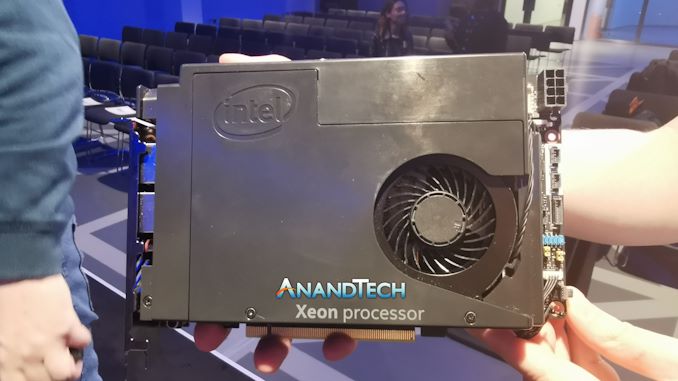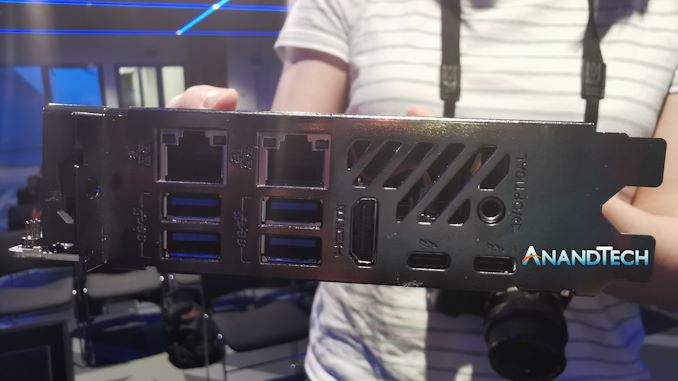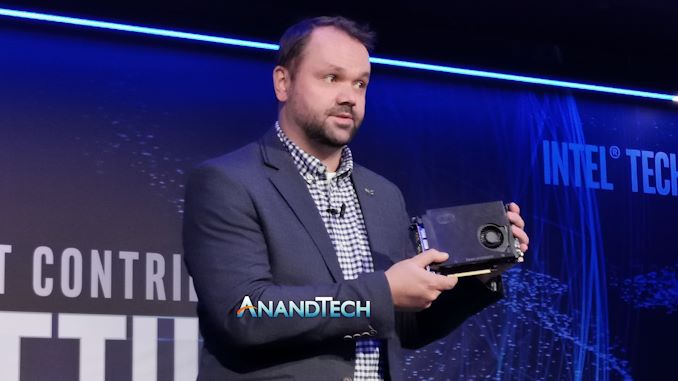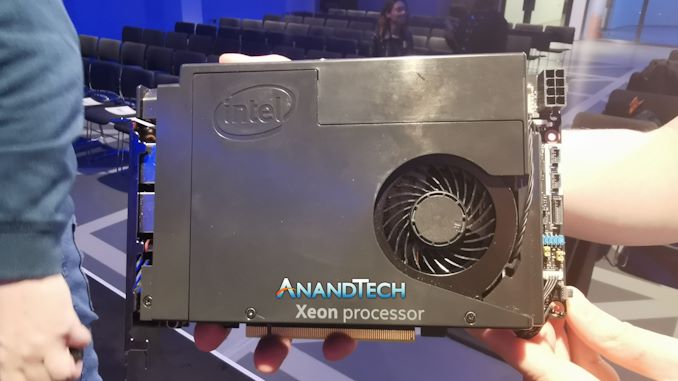The Modular PC: Intel’s new Element brings Project Christine to Life
by Dr. Ian Cutress on October 7, 2019 3:55 PM EST- Posted in
- CPUs
- Intel
- Xeon
- Razer
- NUC
- PCIe
- Compute Element
- Project Christine
- Intel Element

Way back at CES 2014, Razer’s CEO introduced a revolutionary concept design for a PC that had one main backplane and users could insert a CPU, GPU, power supply, storage, and anything else in a modular fashion. Fast forward to 2020, and Intel is aiming to make this idea a reality. Today at a fairly low-key event in London, Intel’s Ed Barkhuysen showcased a new product, known simply as an ‘Element’ – a CPU/DRAM/Storage on a dual-slot PCIe card, with Thunderbolt, Ethernet, Wi-Fi, and USB, designed to slot into a backplane with multiple PCIe slots, and paired with GPUs or other accelerators. Behold, Christine is real, and it’s coming soon.
‘The Element’ from Intel
Truth be told, this new concept device doesn’t really have a name. When specifically asked what we should call this thing, we were told to simply call it ‘The Element’ – a product that acts as an extension of the Compute Element and Next Unit of Computing (NUC) family of devices. In actual fact, ‘The Element’ is a product of the same team inside Intel: the Systems Product Group responsible for the majority of Intel’s small form factor devices has developed this new ‘Element’ in order to break the iterative design cycle into something that is truly revolutionary.
(This is where a cynic might say that Razer got there first… Either way, everyone wins.)
What was presented on stage wasn’t much more than a working prototype of a small dual-slot PCIe card powered by a BGA Xeon processor. On the card was also two M.2 slots, two slots for SO-DIMM LPDDR4 memory, a cooler sufficient for all of that, and then additional controllers for Wi-Fi, two Ethernet ports, four USB ports, a HDMI video output from the Xeon integrated graphics, and two Thunderbolt 3 ports.
The M.2 slots and SO-DIMM slots are end-user accessible, by lifting a couple of screws from the front. This is in no-way a final design, but just a working prototype. The exact cooler, styling, and even the product name is in no way final yet, but the concept is solid.
The product shown used a Xeon BGA processor, however it was clear that this concept can be moved into consumer processors as well. As with the current NUC family, this would likely migrate into the mobile processors rather than BGA versions of desktop processors, and the fact that there are Thunderbolt 3 ports on the side would hint towards 10th Generation Ice Lake, however Intel stated that all options at this design stage are open at this point.
This whole card has a PCIe slot, which we believe at this time to be PCIe 3.0. It stands to reason that if this Element becomes a generational product, then it would migrate to PCIe 4.0 and PCIe 5.0 / CXL as and when Intel moves its product families onto those technologies. Intel is planning to bundle the card to partners with a backplane – a PCB with multiple PCIe slots. One slot would be designated the master host slot, and the CPU/DRAM/Storage combination would go in that slot. Discrete GPUs, professional graphics, FPGAs, or RAID controllers are examples of cards that could fit into the other slots.
In these configurations, in every instance the CPU compute card is the host, rather than an attached device. Intel does offer CPUs-on-a-card-as-a-device, which is Intel’s Visual Compute Accelerator (VCA), which pairs three Xeon E3 CPUs onto a slave card that is accessed from the host. We asked if Intel has plans that its Element cards could be used as a slave card in this configuration, but Intel stated there are no current plans to do so.
The backplane would also be the source of power. A direct PSU into the backplane would serve as offering 75W to each of the PCIe slots, as well as any other features such as system fans or additional on-backplane controllers. This power could come from a PSU, or from a 19V input, depending on the exact configuration of the system. The Element card we saw had an additional 8-pin PCIe power connector, suggesting another 150W could be powered to the card, giving a total of 225W for CPU, DRAM, and storage: which would beg the question if the card could support something like a Core i9-9900KS.
On the topic of cooling, the demo unit shown had very much a basic cooling setup. As stated, Intel said that this is in no-way the final version of what Intel is trying to do here. When asked if it would be easy enough for users to liquid cool the CPU, the Intel spokesperson said it would be customizable, though it would be up to component manufacturers to enable that themselves.
For board partners, Intel stated that they are not seeing this Element form factor as something that partners would create themselves. In essence, there would be no AIB partners like in the GPU market, but for OEMs that to build pre-built systems, they could take the Element card and customize on top of the Intel design, as well as develop their own backplanes and such.
Ultimately with the Element, Intel wants to make it easier for integrated system upgrades. Customers can keep the chassis, keep the system setup, keep the backplane, and all they would do is change the Element card to get the latest performance and features. This was the ultimate goal with something like Razer’s Project Christine, and is certainly something to work towards. However, by keeping the storage on the Element rather than having it as a separate add-in card, this is somewhat limiting as it would require swapping the drives out. This might not be much of an issue, if one of the PCIe slots on the backplane was used for M.2 drives (or even with drives on the backplane itself).
Intel stated that the plan for the Element to see daylight in the hands of OEMs would be sometime in Q1 2020, likely at the back-end of Q1. Our spokesman said that exact CPUs and configurations are still in flux, and as one might expect, so is pricing. Exactly how the Element will be named is a mystery, and how it will be packaged either to end users or OEMs is a question to answer.
Given that this is a product from the same group as the NUC, I highly expect it to follow the same roll-out procedure as other NUC products. Personally, I think this form factor would be great if Intel could standardize it and open it up to motherboard partners. I imagine that we might see some board partners do copy-cat designs, similarly with how we have several variations of NUCs on the market. Intel stated that they have a roadmap for the Element, which is likely to extend over multiple generations. I theorised a triple slot version with an Xe GPU, and the idea wasn't dismissed out of hand immediately.
We asked about RGB LEDs. The question recieved a chuckle, but it is going to be interesting whether Intel limits the Element to a professional environment or opens it up to more run-of-the-mill users.
We’ve politely asked Intel to let us know when it is ready so we can test. Our Intel spokesman was keen to start sampling when it is ready, stating that sampling budget in this context is not a problem. I think we’ll have to hold them to that.
Related Reading
- Intel Launches the NUC Compute Element for Modular Computing Systems
- Intel's Bean Canyon (NUC8i7BEH) Coffee Lake NUC Review - Ticking the Right Boxes
- EGlobal's NUC-Like PC Packs Intel’s Unlocked Hex-Core i7-8750HK CPU
- Shuttle’s X1 Now Available: NUC-Like PC With a GeForce GTX 1060 GPU
- Memory Frequency Scaling on Intel's Skull Canyon NUC - An Investigation















86 Comments
View All Comments
Ian Cutress - Monday, October 7, 2019 - link
"Aren't desktops modular already?"Technically... yes. 😉
For some reason I'm drawn to this as a concept. Perhaps we're going back to the old days of CPUs on cards.
d0nk3y - Monday, October 7, 2019 - link
Talking about old days, and modular PCs...I got to have a play around with a Canon AS400 modular PC back in the early 90s. This thing came to market before the IBM PC - it had a 640x480 colour screen. It also featured a metal balled mouse that connected to the keyboard, which in turn connected to the base unit. The modularity was in that you could snap on a hard disk module (5MB I think - maybe 10MB). There were single and dual floppy modules too from memory.
The hard disk tech was very cool too - it used power to hold the heads down over the disk surface so - in the event of a power failure - the head would actually lift off the disk rather fall onto it.
Alexvrb - Monday, October 7, 2019 - link
Sounds they took a laptop mainboard and redesigned it to slot into a backplane. Maybe the reason you're drawn to it is nostalgia? Reminds me of those industrial cards that had a CPU socket and RAM slots, plus IDE connectors, that would slot into a baseplate (which could slot several). Or those ill-fated "CPU upgrade cards" that were basically a motherboard+CPU+RAM on a PCI card.Lord of the Bored - Monday, October 7, 2019 - link
CPU upgrade cards on ISA made a degree of sense. I mean, there's still the bottleneck that is ISA, but... everything connected to the processor through ISA ANYWAYS so there wasn't really a huge performance loss.I admit I don't recall the PCI upgrade cards, and my mind is locking up trying to figure out how that would work.
Samus - Tuesday, October 8, 2019 - link
Kind of reminds me of the Apple Power PC "Dos Compatibility" card they made, effectively an entire 486 PC on a card, embedded Sound Blaster Vibra and bus interconnects to share keyboard\mouse\internal speaker with the host PC. Really radical for the time.Googer - Wednesday, October 16, 2019 - link
For years now, I've been wishing for an Android/ ARM (tablet/phone) cpu system on a PCI-e card to help bridge the gap between Windows PC's and Android OS apps. Such a card would function like GPU compute and would work with virtualization with in the OS to run android or other OS.bigfurrymonster - Friday, October 25, 2019 - link
Why? You can emulate Android in a VM on a PCTargon - Friday, October 11, 2019 - link
You may not remember the days of the original Athlon and Pentium 3 where the processors were on cards with a special slot. In those days, you didn't have cache on the CPU, so putting it onto a card with the CPU was the solution. There was also the company ALR that had an 80386SX machine that had a special slot for a daughter card to add a 386DX to bring it up to 32 bit. Slower than just having a 386DX in the first place in the machine, but it did allow upgrade capabilities.Gen-Z uses the entire idea of a system fabric as well, but isn't locked into a given vendor. I've been waiting for AMD to put out a prototype system with Ryzen support for the new design.
futurepastnow - Monday, October 7, 2019 - link
Everything old is new again. This is how the first PCs, like the Altair, worked.Arnulf - Tuesday, October 8, 2019 - link
My thoughts exactly - this should have gone into the "Truth be told ..." paragraph up there in the article. This thing is hardly a novel concept, it's just that the author is a bit on the young side and cannot possibly remember them.